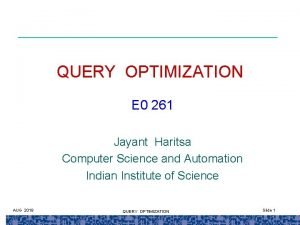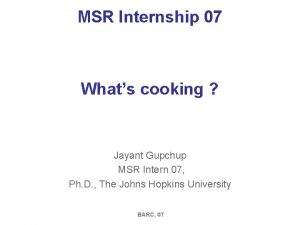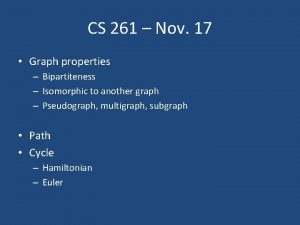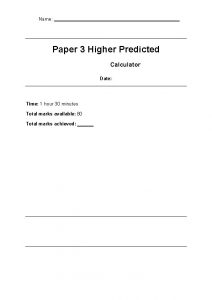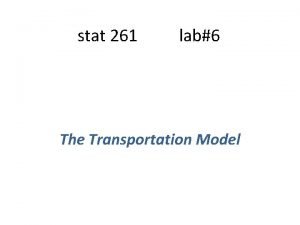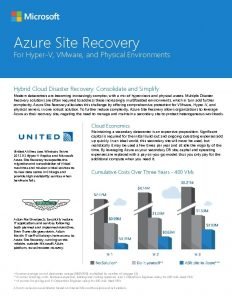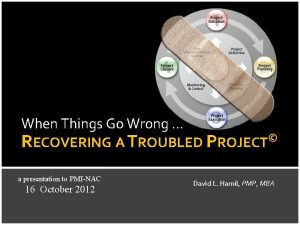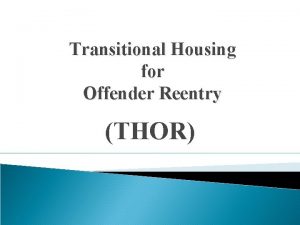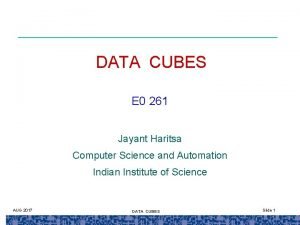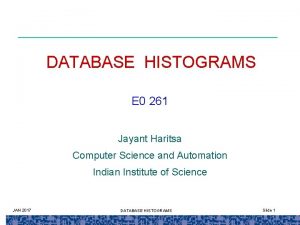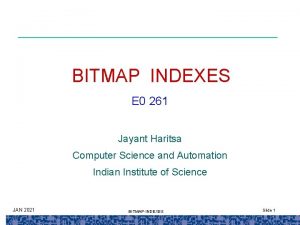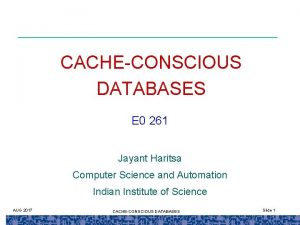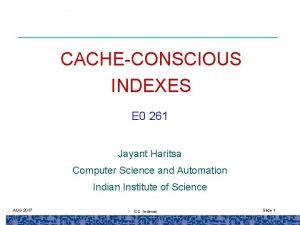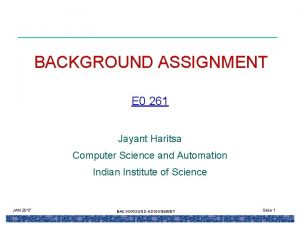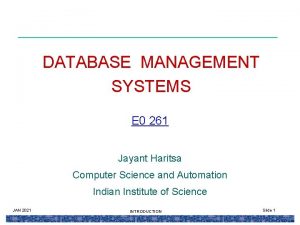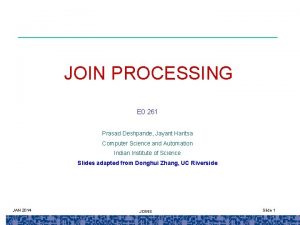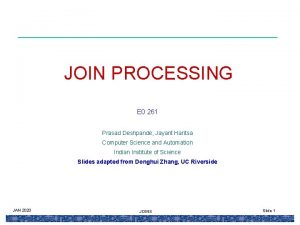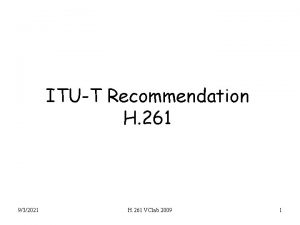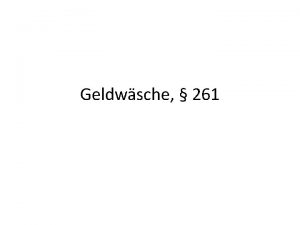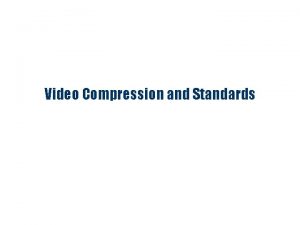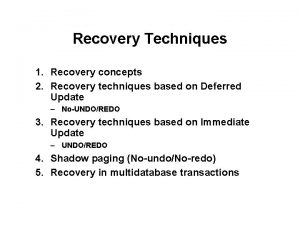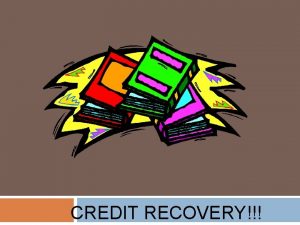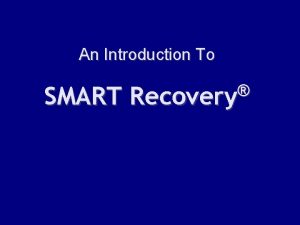RECOVERY MANAGER E 0 261 Jayant Haritsa Computer



































- Slides: 35

RECOVERY MANAGER E 0 261 Jayant Haritsa Computer Science and Automation Indian Institute of Science JAN 2021 RECOVERY MANAGER Slide 1

RECOVERY MANAGER • Atomicity: All actions in the Xact happen, or none happen. • Durability: If a Xact commits, its effects persist. • The Recovery Manager guarantees these properties. JAN 2021 RECOVERY MANAGER Slide 2

Example Scenario crash! T 1 T 2 T 3 T 4 T 5 v JAN 2021 Desired Behavior after system restarts: – T 1, T 2 & T 3 should be durable. – T 4 & T 5 should be erased. RECOVERY MANAGER Slide 3

Design Issues • Database – Updates: In-place or to “shadow” copy ? • Buffer Pool – Commit-Force: Force every memory data write to disk at commit time, or No-Force ? – Frame-Steal: Allow buffer frames of uncommitted Xsactions to be taken by others, or No-Steal? JAN 2021 RECOVERY MANAGER Slide 4

Simple Solution • Shadow updates (instant recovery) • Force (provides durability), No-steal (provides atomicity) • But, – Shadow results in fragmentation – Force results in poor response time – No-steal results in poor throughput JAN 2021 RECOVERY MANAGER Slide 5

High-performance Solution • In-place, No-force, Steal • Mechanisms: – In-place : By using logging – No-force : By recording new value of P at commit time to support REDO of write to P – Steal : By recording old value of P at steal time to support UNDO of write to P JAN 2021 RECOVERY MANAGER Slide 6

LOG • A temporally-ordered list of REDO/UNDO actions • One record for each update, containing <XID, page. ID, offset, length, old data, new data> – <T 420, 3873, 200, 1, B, A> • Sequentially written to separate disk • Several updates captured in single log page JAN 2021 RECOVERY MANAGER Slide 7

Write-Ahead Logging (WAL) • Must force the log record for an update before the corresponding data page gets to disk: guarantees Atomicity • Must force all log records for a Xaction at commit: guarantees Durability. JAN 2021 RECOVERY MANAGER Slide 8

Recovery Protocol Analysis Undo Losers Redo Winners Crash JAN 2021 RECOVERY MANAGER Slide 9

Assumptions • Page-level locking • Simple lock types (S, X) • Physical logging (before-image, after-image) – Trivially guaranteed idempotency of undo and redo operations (ensuring no impact of crashes during the recovery process) JAN 2021 RECOVERY MANAGER Slide 10

To Increase Concurrency • Support operation logging – describe operation, not effects of operation • Support fancy lock modes – e. g. increment/decrement • Support fine-grained locking – record-level JAN 2021 RECOVERY MANAGER Slide 11

Implications • Because of operation logging, no longer trivially idempotent ! (e. g. repeated undo of an increment operation is not equal to that of single undo) • Because of fancy lock types, the value of a data item may reflect the effect of multiple uncommitted updates from different transactions. • Because of record-level locking, a page may simultaneously contain updates of (eventual) losers and winners. (Very) Careful design of recovery protocol JAN 2021 RECOVERY MANAGER Slide 12

Solution: (SC) ARIES ! • Algorithm for Recovery and Isolation Exploiting Semantics • C. Mohan (IBM Fellow) • Industrial Strength Algorithm • Implemented in several commercial products (e. g. IBM DB 2) and research prototypes (e. g. Shore) • Integrates well with other components of the system (data CC, index CC, . . . ) • Main features: CLRs and REDO-ALL JAN 2021 RECOVERY MANAGER Slide 13

The ARIES Method JAN 2021 RECOVERY MANAGER Slide 14

WAL & the Log LSNs DB RAM page. LSNs flushed. LSN • Each log record has a unique Log Sequence Number (LSN). – LSNs always increasing. “Log tail” in RAM • Each data page contains a page. LSN. – The LSN of the most recent log record for an update to that page. Log records flushed to disk • System keeps track of flushed. LSN. – The max LSN flushed so far to disk. • WAL: Before a data page is written to disk, page. LSN flushed. LSN JAN 2021 RECOVERY MANAGER page. LSN Slide 15

Log Records Log. Record fields: type XID prev. LSN page. ID length update offset & CLR records before-image after-image only CLRs only Undo. Nxt. LSN Possible log record types: • Update • Prepared (for distributed) • Commit • Abort • End • Compensation Log Records • Checkpoint Records (Instead of before/after image, logical logging is also permitted) JAN 2021 RECOVERY MANAGER Slide 16

Compensation Log Records • CLRs are redo-only records of the undos of the updates of aborted transactions • Explicitly provide idempotency by keeping track of the rollback status of a transaction • Permits operation logging, page-oriented redo (for efficient recovery), and logical undo (high concurrency during normal processing) • A NO-OP Xaction is equivalent to a committed “aborted + CLR” transaction, hence ensures uniform treatment of losers and winners JAN 2021 RECOVERY MANAGER Slide 17

Transaction Table (TT) • One entry per active Xaction – XID (transaction identifier) – status (running/prepared/committed/aborted) – last. LSN (latest log record written by Xaction) – Undo. Nxt. LSN (LSN of next log record to be undone) Use: ensures no repetition of previously done work • Meant for UNDO pass UN JAN 2021 RECOVERY MANAGER Slide 18

Dirty Page Table (DPT) • One entry per dirty page in buffer pool – Page. ID (page identifier) – rec. LSN (LSN of first log record that caused the page to be dirty). Use: indicates earliest log record which might have to be redone • Meant for REDO pass JAN 2021 RECOVERY MANAGER Slide 19

Checkpointing • Periodically, the DBMS creates a checkpoint, in order to minimize the time taken to recover in the event of a system crash. Write to log: – begin_checkpoint record: Indicates when checkpoint began. – end_checkpoint record: Contains current transaction table and dirty page table. • Other Xacts continue to run; so these tables are guaranteed to be uptodate only as of the time of the begin_checkpoint record. • No attempt to force dirty pages to disk; effectiveness of checkpoint limited by oldest un-forced change to a dirty page. (So it’s a good idea to periodically flush dirty pages to disk!) – Store LSN of begin_checkpoint record in a safe place (master record). JAN 2021 RECOVERY MANAGER Slide 20

The Big Picture: What’s Stored Where LOG DB Log. Records type XID prev. LSN page. ID length offset before-image after-image undo. Nxt. LSN JAN 2021 RAM Xact Table Data pages page. LSN master record Xid last. LSN status undo. Nxt. LSN Dirty Page Table Page. ID rec. LSN flushed. LSN RECOVERY MANAGER Slide 21

Normal Execution of a Transaction • Series of reads & writes, followed by commit or abort. • Strict 2 PL. • STEAL, NO-FORCE buffer management, with Write-Ahead Logging. JAN 2021 RECOVERY MANAGER Slide 22

Transaction Commit • Write commit record to log. • All log records up to Xact’s last. LSN are flushed. – Guarantees that flushed. LSN ³ last. LSN. • Commit() returns. • Write end record to log. JAN 2021 RECOVERY MANAGER Slide 23

Simple Transaction Abort • Explicit abort of a Xaction, no crash involved • Write an Abort log record. • “Play back” the log in reverse order, UNDOing updates. – Get last. LSN of Xaction from TT. – Follow chain of log records backward via the prev. LSN field. JAN 2021 RECOVERY MANAGER Slide 24

Abort (contd) • To perform UNDO, must have a lock on data! – No problem (because of strict 2 PL) • Before restoring old value of a page, write a CLR: – You continue logging while you UNDO!! – CLR has one extra field: undonext. LSN • Points to the next LSN to undo (i. e. the prev. LSN of the record we’re currently undoing). – CLRs never Undone (but they might be Redone when repeating history: guarantees Atomicity) • At end of UNDO, write an “end” log record. JAN 2021 RECOVERY MANAGER Slide 25

Crash Recovery: Big Picture log Oldest log record of Xaction active at crash Start from a checkpoint (found via master record). v Three phases. Need to: v Smallest rec. LSN in dirty page table after Analysis – Figure out which Xactions committed since checkpoint, which failed (ANALYSIS). – REDO all actions (repeat history) – UNDO effects of failed Xacts. Last chkpt CRASH JAN 2021 A R U RECOVERY MANAGER Slide 26

Recovery: The Analysis Phase • Reconstruct state at checkpoint. – via end_checkpoint record. • Scan log forward from begin_checkpoint. – End record: Remove Xaction from TT. – Other records: Add Xaction to TT if not already there, set last. LSN=LSN, change Xaction status for control records. • Update record: If page P not in DPT, add P to DPT, set its rec. LSN=LSN. JAN 2021 RECOVERY MANAGER Slide 27

Output of Analysis Phase • TT is accurate as of crash, and gives the list of all transactions that were active at the time of the crash. • DPT is also accurate as of crash, but may be “conservative” – may include some pages that may have been written to disk. – Could be eliminated by writing an end_write log record at the end of each data page write, but again CISC versus RISC argument holds. JAN 2021 RECOVERY MANAGER Slide 28

Recovery: The REDO Phase • We repeat History to reconstruct state at crash: – Reapply all updates including CLRs. • Scan forward from log record containing smallest rec. LSN in DPT. For each CLR or update log record, REDO the action unless: – Affected page is not in DPT, or – Affected page is in DPT, but has rec. LSN > LSN, or – page. LSN (in DB) ³ LSN. • To REDO an action: – Reapply logged action. – Set page. LSN = LSN. No additional logging! JAN 2021 RECOVERY MANAGER Slide 29

Recovery: The UNDO Phase To. Undo={ l | l is a last. LSN of a loser Xaction} Repeat: • Choose largest LSN among To. Undo. – If this LSN is a CLR and undonext. LSN==NULL • Write an End record for this Xaction – If this LSN is a CLR, and undonext. LSN != NULL • Add undonext. LSN to To. Undo – If this LSN is an update. Undo the update, write a CLR, add prev. LSN to To. Undo. – If this LSN is “abort” or “prepare”, add prev. LSN to To. Undo. • Remove LSN from To. Undo Until To. Undo is empty. JAN 2021 RECOVERY MANAGER Slide 30

Example of Recovery LSN RAM Xact Table last. LSN status undo. Nxt. LSN Dirty Page Table rec. LSN flushed. LSN To. Undo JAN 2021 LOG 00 begin_checkpoint 05 end_checkpoint 10 update: T 1 writes P 5 20 update T 2 writes P 3 30 T 1 abort 40 CLR: Undo T 1 LSN 10 45 T 1 End 50 update: T 3 writes P 1 60 update: T 2 writes P 5 prev. LSNs CRASH, RESTART RECOVERY MANAGER Slide 31

Example: Crash During Restart! LSN 00, 05 RAM Xact Table last. LSN status Dirty Page Table rec. LSN flushed. LSN To. Undo LOG begin_checkpoint, end_checkpoint 10 update: T 1 writes P 5 20 update T 2 writes P 3 30 T 1 abort 40, 45 undonext. LSN CLR: Undo T 1 LSN 10, T 1 End 50 update: T 3 writes P 1 60 update: T 2 writes P 5 CRASH, RESTART 70 80, 85 CLR: Undo T 2 LSN 60 CLR: Undo T 3 LSN 50, T 3 end CRASH, RESTART 90 JAN 2021 CLR: Undo T 2 LSN 20, T 2 end RECOVERY MANAGER Slide 32

Additional Crash Issues • What happens if system crashes during Analysis? – Restart the Analysis phase again During REDO? – Some redos will not be redone since page. LSN will now be equal to update record’s LSN. • How to limit the amount of work in REDO? – Flush asynchronously in the background. • How to limit the amount of work in UNDO? – Avoid long-running Xactions. JAN 2021 RECOVERY MANAGER Slide 33

SUMMARY of ARIES PRINCIPLES • WAL • Repeating history during REDO – Make db accurate as of CRASH • Logging changes (with CLRs) during UNDO – Bounded recovery effort JAN 2021 RECOVERY MANAGER Slide 34

END TRANSACTION MANAGEMENT E 0 261 JAN 2021 RECOVERY MANAGER Slide 42
 Jayant r haritsa
Jayant r haritsa Jayant gupchup
Jayant gupchup Jayant gupchup
Jayant gupchup Jayant madhavan
Jayant madhavan Dr william brugge
Dr william brugge Chandrika jayant
Chandrika jayant Bcbs 261
Bcbs 261 Tp261
Tp261 Texas family code 261
Texas family code 261 Dlpp-167
Dlpp-167 Cs 261
Cs 261 180-116 calculator
180-116 calculator Emt 261
Emt 261 261 sayli mekteb google map
261 sayli mekteb google map 261/2011 kormányrendelet
261/2011 kormányrendelet Stat 261
Stat 261 Manageengine recovery manager plus
Manageengine recovery manager plus Windows azure hyper v recovery manager
Windows azure hyper v recovery manager Acronis startup recovery manager
Acronis startup recovery manager Recovery manager
Recovery manager Senior manager vs general manager
Senior manager vs general manager Portfolio manager synergy manager parental developer
Portfolio manager synergy manager parental developer Objective of computer system
Objective of computer system What is computer organization
What is computer organization Output devices drawing
Output devices drawing Basic structure of computer in computer organization
Basic structure of computer in computer organization Computer architecture and organisation
Computer architecture and organisation Basic computer design
Basic computer design Design of basic computer with flowchart
Design of basic computer with flowchart What are the 16
What are the 16 Wellness recovery action plan examples
Wellness recovery action plan examples Verizon disaster recovery plan
Verizon disaster recovery plan Csos recovery dell
Csos recovery dell Georgia transitional housing for offender reentry
Georgia transitional housing for offender reentry Titan oil recovery share price
Titan oil recovery share price Status withdrawal theory
Status withdrawal theory
